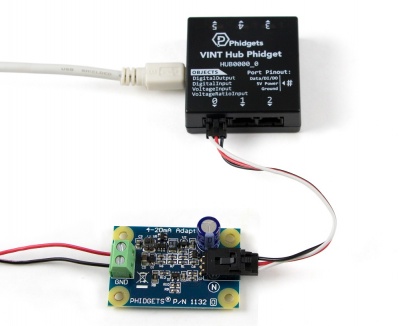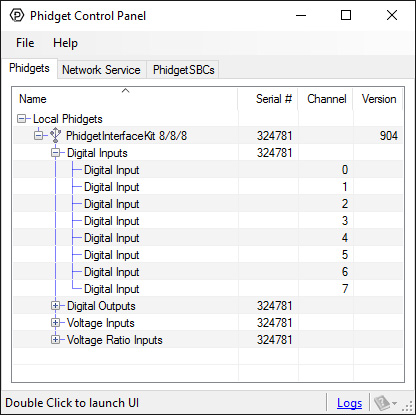1132 User Guide
Required Hardware
- A 1132 4-20mA Adapter
- An InterfaceKit or Hub to read the adapter
- A Phidget cable
- A USB cable
- A computer
- A sensor with a 4-20mA output
Connecting the Pieces

- Connect the 4-20mA Adapter to the InterfaceKit or Hub with the Phidget cable.
- Connect a sensor with a 4-20mA output to the adapter.
- Connect the InterfaceKit or Hub to your computer with the USB cable.
Testing Using Windows
Phidget Control Panel
In order to demonstrate the functionality of the 1018, the Phidget Control Panel running on a Windows machine will be used.
The Phidget Control Panel is available for use on both macOS and Windows machines.
Windows
To open the Phidget Control Panel on Windows, find the ![]() icon in the taskbar. If it is not there, open up the start menu and search for Phidget Control Panel
icon in the taskbar. If it is not there, open up the start menu and search for Phidget Control Panel
macOS
To open the Phidget Control Panel on macOS, open Finder and navigate to the Phidget Control Panel in the Applications list. Double click on the ![]() icon to bring up the Phidget Control Panel.
icon to bring up the Phidget Control Panel.
For more information, take a look at the getting started guide for your operating system:
Linux users can follow the getting started with Linux guide and continue reading here for more information about the 1018.
First Look
After plugging the 1018 into your computer and opening the Phidget Control Panel, you will see something like this:

The Phidget Control Panel will list all connected Phidgets and associated objects, as well as the following information:
- Serial number: allows you to differentiate between similar Phidgets.
- Channel: allows you to differentiate between similar objects on a Phidget.
- Version number: corresponds to the firmware version your Phidget is running. If your Phidget is listed in red, your firmware is out of date. Update the firmware by double-clicking the entry.
The Phidget Control Panel can also be used to test your device. Double-clicking on an object will open an example.
Voltage Input
Double-click on a Voltage Input object in order to run the example: [[Image:{{{1}}}_VoltageInputSensor_Example.jpg|center|link=]]
General information about the selected object will be displayed at the top of the window. You can also experiment with the following functionality:
- Modify the change trigger and/or data interval value by dragging the sliders. For more information on these settings, see the data interval/change trigger page.
- If you have an analog sensor connected that you bought from us, you can select it from the Sensor Type drop-down menu. The example will then convert the voltage into a more meaningful value based on your sensor, with units included, and display it beside the Sensor Value label. Converting voltage to a Sensor Value is not specific to this example, it is handled by the Phidget libraries, with functions you have access to when you begin developing!
For more information about Voltage Inputs, check out the Voltage Input Primer.
Testing Using macOS
- Go to the Quick Downloads section on the macOS page.
- Download and run the Phidget macOS Installer
- Click on System Preferences >> Phidgets (under Other) to activate the Preference Pane
- Make sure your device is properly attached
- Double click on your device's objects in the listing to open them. The Preference Pane and examples will function very similarly to the ones described above in the Windows section.
Testing Using Linux
For a general step-by-step guide on getting Phidgets running on Linux, see the Linux page.
Using a Remote OS
We recommend testing your Phidget on a desktop OS before moving on to remote OS. Once you've tested your Phidget, you can go to the PhidgetSBC, or iOS pages to learn how to proceed.
Technical Details
Sensors can be connected to and powered by the provided terminals on the 4-20mA Adapter board. The Phidget will measure the current passing through the attached sensor and convert it to a voltage, where it can be displayed as a SensorValue by an Interfacekit. The adapter board is a non-ratiometric device, so make sure to set ratiometric to false when using an Interfacekit. If the formula gives a range below 4mA (a SensorValue less than 180), then this indicates that the sensor is “open”. The 4-20 mA Adapter board internally produces +15V from the Phidget InterfaceKit’s input analog voltage. This supply rail is used to power the connected sensor, eliminating the need for other external power supplies. If the Adapter board is being used in very noisy environments, place a ferrite bead on the sensor current loop close to where it is attached to the 1132. This helps prevent energy coupled into long runs of wiring from causing computer problems.
Formulas
The Formula to translate SensorValue into current consumed is:
Selecting a 4-20mA Sensor
Review the datasheet for the 4-20 mA sensor that you have selected to be certain that it complies with the specifications of the Adapter Board. Mostly you want to make sure that the sensor you want to use does not require more than 15V and that its capacitive load is equal to or less than 1.5µF. The following sensor has been successfully tested with the 1132.
| Manufacturer | Part Number | Description |
| Honeywell | SPTmA0015PG5W02 | Stainless Steel 0-15 psi Pressure Sensor |
Phidget Cable

The Phidget Cable is a 3-pin, 0.100 inch pitch locking connector. Pictured here is a plug with the connections labelled. The connectors are commonly available - refer to the Analog Input Primer for manufacturer part numbers.
What to do Next
- Programming Languages - Find your preferred programming language here and learn how to write your own code with Phidgets!
- Phidget Programming Basics - Once you have set up Phidgets to work with your programming environment, we recommend you read our page on to learn the fundamentals of programming with Phidgets.

